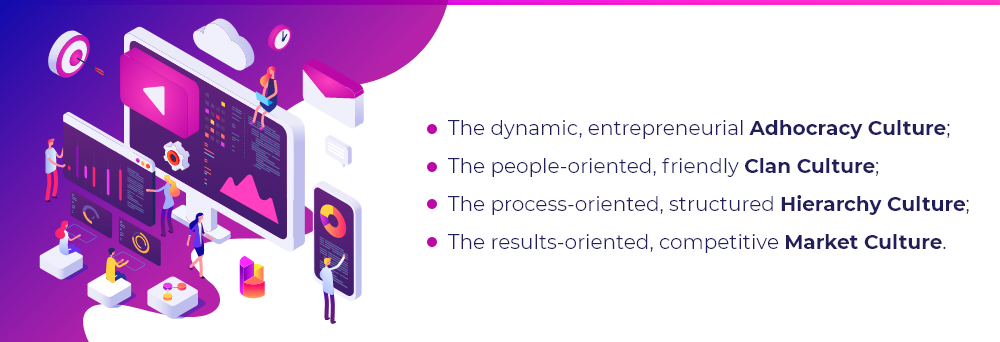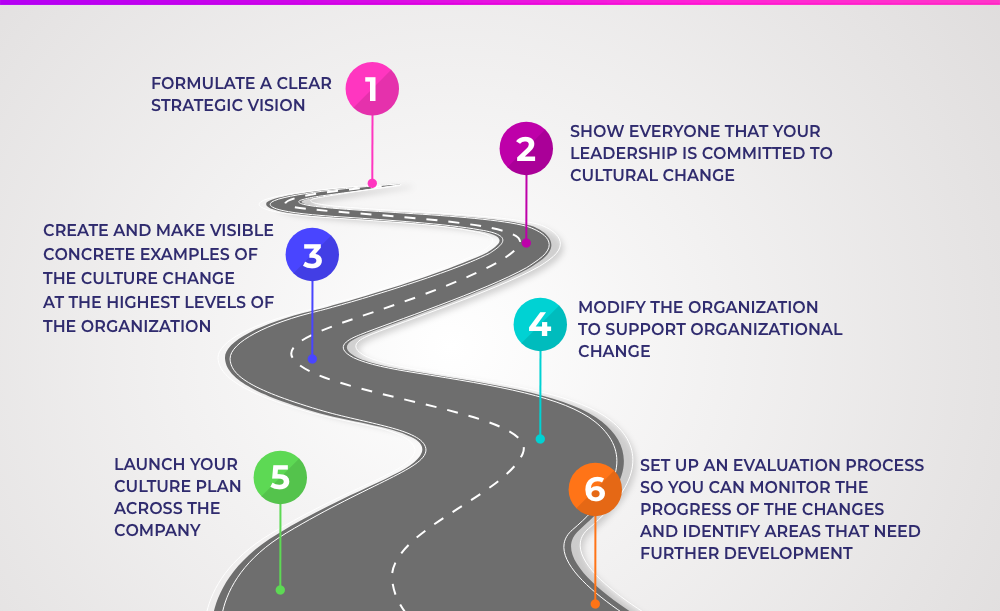Types of organizational culture: which one best suits you?
No two cultures are the same but many share defining characteristics that allow us to define the different types of organizational cultures. Which prevails in your company?
Culture is the glue that binds organizations together. Whichever type of organizational culture prevails in your company, its formula is based on the “accepted” or “shared” ways people do things and how they organize themselves to do them. Furthermore, how your employees and leadership teams interact with one another is largely determined by the beliefs and behaviors rooted in your organizational culture.
How important is culture? According to Harvard Business School professor Howard Stevenson, “[m]aintaining an effective culture is so important that it, in fact, trumps even strategy.”
According to one study, over half of the senior executives surveyed believe that corporate culture is a top-three driver of company value and 92% believe that improving their culture would increase their firm’s value. Surprisingly, only 16% believe their culture is where it should be. Why is culture so often left to chance or overlooked?
It’s not uncommon to see organizational cultures that have developed organically over time. In some companies, culture is implied with new hires mimicking colleagues and adopting traits they see in their coworkers. However, demystifying your type of corporate culture by expressly defining it will benefit all of your stakeholders: customers, suppliers, employees, and leadership. Companies that consciously design their culture have the opportunity to convert it into a tangible asset that will set them apart from the pack.
The flip side is leaving your culture to evolve unintentionally or haphazardly, which can convert it into a damaging liability.
By giving employees a clear window into your values, vision, and purpose, you will be able to engage them more effectively. It can also help attract, recruit, and retain the best talent. Employees will better understand how they can make a difference, grow within the company, and fulfill their potential.
Identifying Your Type of Organizational Culture
Of course, no two organizational cultures are exactly the same. But there are common characteristics that allow us to categorize or group them into different types of corporate culture.
Several factors can influence the category a company falls into e.g., industry, history, size, or location but even when these factors come into play and a company’s culture is leaning strongly in a particular direction, it is not a fated existence. Culture can be changed. It’s not static. It is constantly evolving.
Some experts break down organizational culture into four main categories, others list five or even eight types of corporate culture. The latter is the case of the authors of “The Leader’s Guide to Corporate Culture.” They have identified eight distinct culture styles:

Another commonly used tool when it comes to assessing corporate culture is the Organizational Culture Assessment Instrument (OCAI). Developed by professors Kim Cameron & Robert Quinn at the University of Michigan, OCAI is based on the Competing Values Framework (CVF) tested for over 30 years in organizations. OCAI defines four culture types:

Their alternative, easy-to-remember names are Create, Collaborate, Control, and Compete Cultures.
Whichever list you choose to base your initial assessment on, the goal is the same. By defining your culture based on a distinct style, you will be able to state clearly and concisely what is truly valued inside your organization.
Shaking Up Organizational Culture
So what happens if you decide you don’t like the culture your company has developed? Good news. You can change it. As we said in the beginning, culture is not static; it’s continually evolving.
In determining whether you have the right culture, it’s important to ask whether the type of organizational culture in your company is the one that best serves your employees, your customers, and the business. If it isn’t, then it’s time to shake things up.
When it comes to creating cultural change, like the number of different types of organizational cultures out there, the exact number of steps varies from one expert to another but most agree on six vital components.

Step 1: Formulate a clear strategic vision for communicating what it is your organization values above all else and then tell people how you are going to implement the cultural change effectively. This is a culture plan or culture deck. Lay it all out clearly and concisely.
Step 2: Show everyone that your leadership is committed to cultural change. A clear sign that the upper echelons of management are committed to the new culture is vital to the success of implementing the change in the rest of the organization.
Step 3: Create and make visible concrete examples of the culture change at the highest levels of the organization. Identify change agents and your top influencers at every level to act as ambassadors of the new culture.
Step 4: Modify the organization to support organizational change. Are there systems, policies, procedures, or rules that need to be changed and aligned with the new values and desired culture? From benefits and reward structures to recruitment and retention programs, you need to ensure that they are aligned with the new values. (Tip: Go back to Step 1 and modify your culture plan, incorporating the new policies and procedures now aligned with your new cultural identity.)
Step 5: Launch your culture plan across the company. A culture platform like StarMeUp OS can ensure that your employees have the tools to adopt the new values and incorporate them into their daily work lives. Make sure to include training so all your employees understand the new processes, expectations, and systems.
Step 6: Set up an evaluation process so you can monitor the progress of the changes and identify areas that need further development. Using the data metrics and people analytics features of culture platforms like StarMeUp OS can help you track the change and understand what is going on behind the numbers. This step will also identify any obstacles to change and employees who may be resistant to the process.
Got culture?
By cultivating and curating your culture, you can convert it into one of your greatest assets. And in light of the abrupt changes in response to COVID-19 leaving many leaders grappling with how to successfully lead their business through the turmoil, there has never been more urgency to shape and drive the most effective culture for your company.
Innovating your culture can be an arduous task because you will be requiring something new and oftentimes substantially different from your employees. But, once you get it right, culture and people-driven technology can ensure that your culture always reflects what you value the most as an organization.
The best type of corporate culture is the one that serves your employees, your customers, and your business to ensure continued success and vitality.